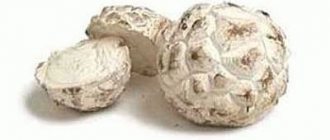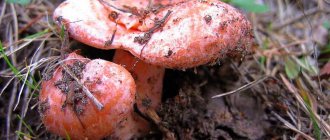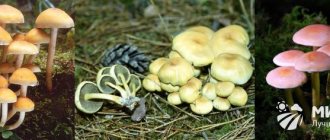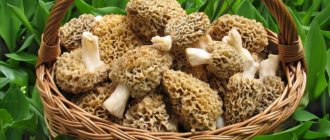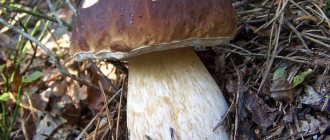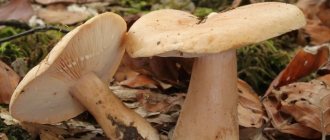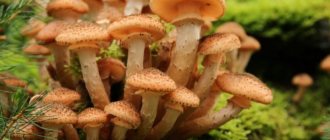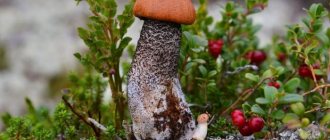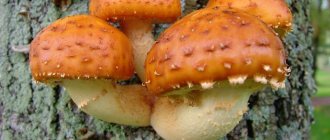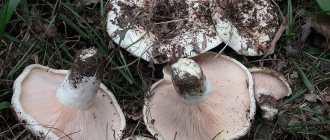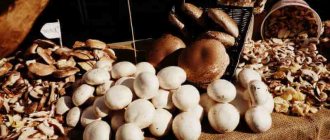Meadow mushrooms have long been famous for their sweetness, healthfulness and pleasant mushroom aroma. Mushrooms from the Negnyuchnikov family belong to the category of edible mushrooms, used for food consumption, both fried and boiled, and pickled and salted. Based on the name, it is not difficult to understand where to find protein fruits rich in vitamins, macro- and microelements. The most important thing is to go searching during the season, after precipitation has fallen. It is best if at least 4-5 days pass from the beginning of the rains to quiet hunting. During this period of time, the mushrooms will not only have time to germinate, but will become sufficient for collection and consumption after heat treatment.
People call meadow mushrooms differently. One of the popular names today is clove mushroom. The meaning of the unusual adjective used in the phrase is associated with the appearance of the honey mushroom. The small size, combined with a straight cap with a convexity in the middle, reminds many mushroom pickers of screws used in construction. The aroma is clove-like, hence the name, combining form and smell.
The second popular name is - negnyuchnik. An interesting, but at the same time frightening word, characterizes mushrooms as a long-term storage product. Regardless of the mating conditions, honey mushrooms growing in the meadow do not rot, but only dry out. If the meadow representatives of the family are not collected in time, the leg will quickly wither and fall off, giving the cap the opportunity to disperse spores around the nearby area.
Alternative names known today remain: meadow talker, marasmius and meadow grass. The latter option is most often used in villages and settlements, where in the old days they used abbreviated names.
Meadow honey fungus, description and main features of the mushroom
Comparing the meadow breed with others, the following distinctive features are distinguished:
- spherical cap, the diameter of which is no more than 6-8 cm;
- a bulge or tubercle located in the middle of the hat, making the appearance of the mushroom similar to an umbrella or French beret;
- the shade of the cap is light brown, less often reddish or dirty yellow;
- The density of the upper part is thin, not distinguished by thick flesh. If you look at it from above
- rays of the sun, you can see gaps;
- the edges are uneven with small teeth;
- the leg is thin and elongated, different in height from the cap. Its color is less pronounced and lighter. Compared to the cap, the density of the stem is high and retains its shape well even after harvesting;
- the ring connecting the lower and upper parts is missing, making the mushroom a prominent representative of the Strophariaceae family.
Important!
When collecting, every mushroom picker needs to know that meadow mushrooms do not belong to the Negnyuchnikov species. Due to this and the slippery state after rain, many characterize mushrooms as hygrophanic.
The plate is rarely located under the cap. Wide divisions can be painted in different tones, depending on weather conditions. For example, after rain or when growing near swampy areas, they turn red and brown. During prolonged drought and active sun, when the mushrooms lack moisture, the plates become white or light beige, closer to cream.
In cross section, each mushroom is light yellow. When pressed and laid down, the shade does not change, remaining exactly the same. By its aroma, honey fungus can be confused with a spicy seasoning: cloves or almond powder.
Interesting fact! At night, honey mushrooms sprouting in the fields have the ability to glow. This unusual ability does not in any way affect the edibility of the mushrooms. After cooking, they remain just as healthy, tasty and aromatic.
Honey mushrooms - false and edible
At first glance, false and edible honey mushrooms are extremely similar. They have approximately the same color of the cap, a similar arrangement of plates on its inner side, and edible and poisonous species grow in the same places.
Note: The mushroom got its name due to the fact that its mycelium develops on old stumps or fallen tree trunks, and this feature is relevant for both poisonous and edible representatives.
The stems of these mushrooms are thin and hollow inside. The surface of the cap is in most cases smooth, but in edible species it can often be covered with scales. The color of the cap and pulp directly depends on the type of tree on which the mushrooms grow. For example, on coniferous trees they take on a brick-red hue, on linden or aspen they become bright yellow, and on oak they can be slightly reddish. In addition, the shade of the pulp may depend on the time of year and the type of mushroom itself.
Figure 1. This is what poisonous twins look like
Experienced mushroom pickers can distinguish a false mushroom from an edible one the first time, while beginners may have some difficulty with this. In order for you to gain the necessary experience in identifying real and false specimens, we suggest that you familiarize yourself with the distinctive features of edible species and their poisonous counterparts. You can see photos of false specimens in Figure 1.
Meadow honey mushrooms, where and how do they grow?
Few people know, but the edible agaric mushroom from the genus Negniyuchnik can be collected not only in Russia, Ukraine and Belarus, but also in the countries of Europe and Asia. Quite often, representatives of honey mushrooms sprout in Australia and America. Less commonly, mushrooms can be found in North Africa during the onset of cooler climates. The most important thing is to look in the right places where myceliums are most often located. We are talking about fields and meadows, wetlands. From mid-May to the end of October - beginning of November, detecting witches' circles will not be difficult. Honey mushrooms, like other mushrooms that resemble weeds, germinate in families, forming circles over vast areas.
Having decided where to go for meadow mushrooms, the mushroom picker should decide on the containers for collecting. The fragile pulp does not allow the fruits to be collected in bags and bags. Even after an hour, the protein product will turn into porridge, unsuitable for further processing and cooking. To avoid a common beginner mistake, you should prefer plastic buckets or baskets. The small size will not allow one person to collect more than two buckets. The mushroom picker will get tired or there simply won’t be enough time to leave the green zone before it gets dark.
Seasonal types of honey mushrooms: photos and descriptions
Look at the seasonal types of honey mushrooms in the photo, which shows summer, autumn, and winter honey mushrooms:
Summer honey mushrooms
Summer honey mushrooms
Autumn honey mushrooms
Autumn honey mushrooms
These types of honey mushrooms are very common, but only at certain times of the year. This is where their names come from.
Seasonal honey mushrooms, their types and descriptions are presented further on the page, you can see them in the photo:
Winter honey fungus
Winter honey fungus
Winter honey fungus
Winter honey fungus
Doubles - be on the lookout!
A clear example allows you to identify real meadow mushrooms from false ones after the first quiet hunt, carried out together with an experienced mushroom picker. The experience and knowledge transferred during the fishing process is unlikely to be replaced by an encyclopedia, a brief description and photo examples. However, if there is no such option for studying distinctive features, you can start learning using alternative options. Combining all the secondary options, a beginner who decides to join the mushroom business can easily cope with his first hunt.
Important!
If you have doubts during mushroom picking, you should not take risks, hoping for luck. It is worth worrying about your health, preferring to be left with an empty bucket, instead of poisoning and intoxication of internal organs.
The most common mistake made by both beginners and experienced mushroom pickers is collecting wood-loving collibia. Instead of meadow representatives, it often ends up in the baskets and buckets of lovers of quiet hunting. True, in comparison with other species similar in appearance, this double is harmless. Its alternative name is spring (summer) honey fungus. Germination lasts until mid-August. You can meet it not only in the forest zone, but also in open areas where grass and weeds grow. A representative of the Negniuchnikov species belongs to the conditionally edible mushrooms and is well suited for consumption after heat treatment and initial boiling. And although its value is minimal, the mushroom has connoisseurs who prefer mushroom dishes without a pronounced aroma and taste.
The second twin of the meadow honey fungus is the buttercollibia. Another conditionally edible mushroom, which is large in size. Appearance - almost identical to meadow grass. It differs only in the absence of aroma and bright taste of mushrooms.
Simple but clear distinctive features will allow you to avoid confusing meadow mushrooms with collibia or other mushrooms:
1) a bulge located in the middle of the hat. In edible honey mushrooms it is more pronounced than in its counterparts;
2) the plates should be sparse, but uniform, painted the same color. If inclusions and irregularities, red or reddish spots are observed, the mushrooms have nothing to do with honey mushrooms. Most likely, there was a collibium on the way;
3) any honey mushrooms smell pleasant, and meadow mushrooms are no exception to the rule. Comparing edible non-rotworms with collibia, the latter have a repulsive aroma, reminiscent of spoiled food or mold. Honey mushrooms have an unusual aroma, combining mushroom notes with spicy cloves.
The poisonous twin of meadow mushrooms remains the white talker. Its alternative name is whitish. After consuming it, symptoms appear quickly, regardless of the chosen method of heat treatment and volume of consumption. Symptoms of poisoning become well expressed after 45-70 minutes. Signs include: dizziness, loss of consciousness, cold sweat, severe dizziness, stabbing pain in the abdominal area.
Only a novice mushroom picker who has no experience in quiet hunting can confuse the white talker with the meadow honey fungus. Bright distinctive features catch the eye even from afar. The first ones are large, reminiscent of autumn honey mushrooms, having a snow-white cap turned towards the stem. The smooth edge has no jagged edges or irregularities.
Today there are many varieties of talkers. Some are conditionally edible, others are inedible, and others are completely poisonous and can cause irreparable harm to health. In total, there are more than 200 species.
Helpful information!
Unfortunately, experienced mushroom pickers can also make a mistake at the time of collection and accidentally put a poisonous mushroom in their basket. However, if you are lucky enough to discover a find during washing and cleaning, you should not risk your health. It is recommended to discard the entire crop so that the released poison cannot be absorbed into the pulp of healthy fruits. And most importantly, it is prohibited to consume collected mushrooms with alcohol. In case of an error, the combination of degrees with toxins and poisons can lead not only to poisoning, but also to death. Internal organs cannot cope with the load. You can suspect something is wrong based on the main signs: redness of the cheeks and neck, swelling, loss of coordination and consciousness.
You should be extremely careful when collecting meadow honey mushrooms in certain regions where fiber grass grows. Despite the large number of varieties, each mushroom from the family is poisonous. In terms of external signs, it is clearly different from honey mushrooms. The plates are grayish and darken in adulthood, becoming yellow-brown and even brown.
How to distinguish between edible and false
You can use real ones to prepare different dishes - classic ones that are familiar to us, or gourmet delicacies. Poisonous ones are dangerous to health and life. They are quite bitter and look edible. Before harvesting, you should look at the photo and read the detailed description.
Common false species include:
- Wood-loving collibia. Unlike edible honey fungus, it grows under rotten leaves in wooded areas. The leg is small, the cap has a whitish tint. It has a persistent unpleasant odor.
- Talker. This poisonous mushroom comes only in white. It grows in open spaces and has a short stem.
- Winter, summer honey fungus. Outwardly they resemble real ones, but they grow only on tree stumps. They can be edible or fake.
It is worth remembering that even edible mushrooms can become dangerous to humans if they grow next to poisonous ones. You should not collect them if they are close to each other. Before cooking, rinse the product thoroughly with running water. A special solution for washing vegetables is also suitable.
Article to read - Where and how honey mushrooms grow.
How to distinguish edible meadow mushrooms from false ones? Main differences
To determine whether a product is beneficial or harmful to the body, you should avoid collecting mushrooms that have the following characteristics:
- high leg;
- a repulsive smell that does not have pleasant notes of mushrooms or cinnamon. Instead of the usual aroma there will be
- emanate a foul plume of mold and spoiled food;
- poisonous representatives usually have a dark or, conversely, extremely light cap in a grayish tone;
- on the reverse side the plates are thin, bright orange, brown, gray or greenish in color.
Description
hat
Smooth, in a young mushroom - in the shape of a hemisphere, later - spread out, retaining a tubercle in the center. The diameter of the cap is from 3 to 6 centimeters. The color of the skin in dry weather is from cream to light brown, after rain - from ocher to red-brown. The edges of the cap are thinned and brittle.
Leg
Fibrous, 4-5 millimeters thick and 5-6 centimeters in height. Sometimes slightly curved, velvety to the touch, color from light ocher to brown. Old mushrooms have a hard, woody stem.
Spore-bearing layer
Lamellar. The plates are infrequent, adherent, but in old mushrooms they are free-growing. The spore powder is white, the spores are spherical and smooth.
Pulp
Cream to ocher in color, brittle on the cap. It has a pronounced sweetish taste and a characteristic aroma of cinnamon or cloves.
Beneficial features
Each mushroom contains:
- vitamins B and C;
- vitamins PP;
- folic acid;
- potassium and magnesium;
- phosphorus and manganese;
- iron;
- large amount of protein and natural fat;
- minimal carbohydrate content.
The usefulness and low calorie content of the product will allow you to consume meadow mushrooms not only during the diet, but also during proper nutrition and fasting. But putting your health at risk is not recommended for pregnant women, women during lactation, children under 13 years of age, as well as those who have chronic diseases of the gastrointestinal tract, liver and kidneys. People with diabetes and individual contraindications should try dishes with meadowsweet with special caution.
In folk medicine, meadow mushrooms can be used as a medicine to treat the following diseases: Staphylococcus aureus, bronchitis, active tuberculosis, pneumonia.
Forest gifts contain a substance that is used today for preventive purposes against oncology.
In China, mushrooms are used to treat ailments such as:
- convulsions;
- thrombophlebitis;
- radiculitis;
- arthritis.
Other types of edible honey mushrooms: what they look like, photos
We invite you to look at other types of edible honey mushrooms in the photo, which illustrate the appearance of the bulbous and dark honey mushrooms:
Bulbous honey fungus
Dark honey fungus
It is necessary to know what edible honey mushrooms look like, since most of the presented species have false poisonous counterparts.
Processing before cooking
The fragility of mushrooms does not allow the product to be left for a long time without processing. To preserve freshness, pleasant aroma and value, you should begin primary processing immediately upon arrival from a quiet hunt. Cooking should begin according to the instructions, following the step-by-step instructions:
1) sorting through the entire crop (removing wormy and damaged honey mushrooms); 2) thorough rinsing under running water to remove as much dirt as possible (adhered leaves, greenery, sand and soil); 3) cleaning each mushroom with a toothbrush; 4) soaking in salted water for 1 hour; 5) primary boiling with further draining of water and repeated washing and drying on a cutting board.
Dangerous double honey mushrooms
Galerina bordered
(Galerina marginata) - deadly poisonous. Grows from June to the end of October on stumps and rotten wood, mainly coniferous trees (less often deciduous). Sometimes appears on the ground that contains fragments of decaying wood. Most often found in small groups. This mushroom has the greatest similarity with summer honey fungus, and relatively little with winter honey fungus. The main difference between the bordered galerina and the summer honey fungus is the absence of scales on its stem. In addition, summer honey mushrooms have a pronounced, pleasant mushroom smell, while in galerina it is extremely weak (according to some sources, slightly mealy). The mushroom contains amatoxins, the same ones found in the toadstool. Symptoms of poisoning appear 6-30 hours after eating mushrooms. A lethal dose is approximately 20-30 small fungi.
How to cook: methods and recipes + photos
Cooking meadow mushrooms today represents many recipes for national Russian cuisine. Cookbooks offer you to familiarize yourself with and repeat many options for dishes belonging to the category:
- first courses;
- second courses;
- salads;
- snacks;
- preparations for the winter, including: pickling and salting.
Marinating meadow mushrooms, classic recipe
To prepare honey mushrooms, you should carry out the initial heat treatment described above, and then boil the mushrooms again, although now with a tasty marinade consisting of the following components:
- 4 liters of water;
- 3 kg of mushrooms;
- 3 table. l. table salt;
- 2 onions, chopped into rings;
- salt, spices and dried herbs.
All components are boiled for 45-55 minutes over low heat. When ready, the mushrooms are caught using a slotted spoon and placed in three-liter jars, previously sterilized in a water bath. Leaving a free space of 3 fingers, the meadows are filled with marinade and closed under metal lids. After seaming, the canned food is turned over, covered with a sweatshirt or old blanket, and left to cool completely. The finished workpiece is placed in a dark but cool place, without direct sunlight.
Freezing
If you decide to freeze honey mushrooms collected in meadow conditions, double boiling is required, with the water drained. There is no need to rinse the mushrooms again! After the last preparation, the mushrooms are caught using a slotted spoon into a sterile container, and then cooled, covered with a lid and sent to the oven.
Making soup
There are plenty of recipes for classic soup with meadow mushrooms. If you wish, choosing one will not be difficult. The most important thing is to follow the step-by-step instructions and pay attention to the photo.
Drying
It is quite simple to answer the question whether it is possible to dry meadow mushrooms or not. Almost all edible forest products can be processed in this way, and these mushrooms are no exception to the rule. If desired, each mushroom picker can dry the harvested crop using an oven or electric dryer.
Cooking recipes
Meadowsweet can be called a universal mushroom. All types of culinary processing can be applied to it: pickling, freezing, pickling, frying. It does not lose its properties when frozen, and when dried and crushed it becomes a rich seasoning for preparing soups, main courses and sauces.
Reference! The legs of mushrooms are too hard, so they are rarely used in cooking. It is advisable to eat only the caps; the legs have too hard a consistency.
Primary processing
After collecting meadow mushrooms, you should immediately begin their primary processing, because they tend to change their shade to a darker one.
How to clean:
- Sort out suitable fruiting bodies, removing old and moldy ones.
- Wash each mushroom to remove forest debris, aphids, bugs, and parasites.
- Remove legs.
Reference! If the mushrooms are intended for drying, then there is no need to wash them under running water; to clean it, it is enough to remove excess dirt with a knife or toothbrush.
When pickling or salting, other primary processing will be required:
- Soak the mushrooms in warm water for half an hour.
- Remove the film from the cap.
- Cut off the legs.
- Rinse with running water.
Cooking
Mushrooms are cooked in salted water along with spices. For 2 liters of liquid take 1 tbsp. l. table salt. The duration of cooking depends on how you plan to use the mushrooms in the future:
- for pickling, honey mushrooms should be cooked for about an hour and a half along with spices until cooked;
- for frying, stewing - cooking lasts about an hour along with spices, salt, onions;
- for freezing – 30-60 minutes.
Dried mushrooms do not need long heat treatment; it is enough to simmer them over the fire for about 20-25 minutes.
Reference! When cooking, be sure to replace the first water with boiling water once 20 minutes after the start of cooking. This process can only be ignored if pre-dried mushrooms are boiled.
Pickling
Meadow mushrooms can be combined with almost any spices, so you don’t have to be afraid to add them in the quantities you like. But there is also a universal marinating recipe.
Ingredients:
- boiled honey mushrooms – 1 kg;
- purified water – 1.5 l;
- table salt – 2 tbsp. l.;
- sugar – 2 tbsp. l.;
- table vinegar (9%) – 4 tbsp. l.;
- black and allspice peas – 10 pcs.;
- cloves – 3 pcs.;
- bay leaf – 3 pcs.
How to cook delicious pickled meadow mushrooms - step-by-step description:
- Add spices, salt and sugar to boiling water.
- Cook over high heat for about 5 minutes, then pour in the vinegar and reduce the flame.
- Add boiled honey mushrooms and cook for another 5-10 minutes.
- Remove from heat, place honey mushrooms in prepared jars, pour warm marinade, and roll up.
- Turn it upside down, wrap it up, wait until it cools completely and move it to a cool place.
Freezing
For freezing, meadow mushrooms are used, which must first be boiled for half an hour to an hour, once replacing the water with boiling water. Next you need:
- Rinse the boiled fruit bodies again under running water.
- Cool.
- Place in hermetically sealed bags, from which all air must be released after filling.
Frying with potatoes
Meadow mushrooms are very tasty along with fried potatoes. For frying, you can use either whole caps, if they are not too large, or large ones, which should be cut into pieces.
Ingredients:
- peeled potatoes - 700 g;
- boiled meadow mushrooms - 700 g;
- vegetable oil – 70 g;
- onions – 1 pc. (large);
- salt and pepper - to taste.
How to prepare fried meadow mushrooms with potatoes:
- Cut the potatoes into small pieces.
- Chop the onion as finely as possible.
- Pour vegetable oil into a large frying pan and heat slightly.
- Add potatoes and onions, fry over medium heat without a lid, stirring occasionally to avoid burning.
- As soon as the potatoes are fried about halfway, add mushrooms, salt, pepper and mix thoroughly.
- Fry until golden brown.
- Turn off the heat, cover with a lid, wait 10 minutes.
- Serve with sour cream sauce.
Pickling
Meadow honey fungus is ideal not only for pickling, but also for pickling. The cooking process is quite simple, and the mushrooms will be completely ready in 45-50 days.
Ingredients:
- fresh honey mushroom caps – 2 kg;
- table salt – 40 g;
- purified water – 1 l;
- dill umbrellas – 3-4 pcs.;
- bay leaf – 3-4 pcs.;
- garlic – 1 head;
- black peppercorns – 5-10 pcs.
Brief instructions for preparing pickles:
- Clean the caps from debris and fill with water.
- Soak for 3-4 days, change the water periodically.
- Rinse under running water.
- Place an umbrella of dill, a few cloves of garlic, a bay leaf and some black peppercorns on the bottom of the container, and on top a layer of mushrooms 3-4 cm high.
- Fill the entire container in the same way.
- Prepare a brine solution from 40 g of salt dissolved in 1 liter of water.
- Pour it over the mushrooms to the level of the top layer.
- Cover with a lid and place under pressure.
Drying
Meadow mushrooms are dried in a not too hot oven or electric cabinet, like other types of mushrooms. Dried honey mushrooms acquire a pronounced mushroom taste and aroma.
How to dry honey mushrooms for the winter:
- Clean mushrooms from forest debris using a sponge or toothbrush. There is no need to wash them.
- Cut off the legs.
- Sort thoroughly, remove damaged and wormy caps. Cut large ones into slices.
- Place on a baking sheet lined with parchment paper.
- Heat the oven to 45 degrees, place the mushrooms in it.
- Open the door slightly for 10-15 minutes so that the moisture evaporates faster.
- As soon as the top of the caps is dry, increase the temperature to 60-70 degrees.
- Dry for 4-6 hours, periodically opening the oven slightly to release moist air.
Reference! Dried honey mushrooms become very fragile, so they easily crumble into powder, which can later be used to prepare sauces. If you want to preserve the structure of the caps, then during the drying process you need to periodically knead them with your fingers so that they dry and do not crumble.
Salad "Polyanka"
This layered salad is prepared with various mushrooms. But it tastes best with pickled honey mushrooms.
Ingredients:
- canned salted mushrooms – 200 g;
- ham – 200 g;
- green onions - to taste;
- eggs – 4 pcs.;
- potatoes – 3 pcs.;
- mayonnaise - to taste.
How to prepare a delicious mushroom salad:
- Boil potatoes and eggs. Let cool.
- Finely chop the onion.
- Chop the ham into cubes.
- Grate potatoes and eggs on a coarse grater.
- Layer the salad in layers, starting from the top: mushrooms, onions, eggs, mayonnaise, ham, mayonnaise and potatoes.
- Let the salad soak. Cool in the refrigerator.
- Turn over so that the meadows are on top.
Reference! To prevent the salad mass from being deformed when turning over, the sides of the storage container should be greased with vegetable oil.
Soup
Soup with meadow mushrooms turns out rich and tasty. And it is prepared from the most familiar products.
Ingredients:
- fresh honey mushrooms – 300 g;
- potatoes – 500 g;
- carrots – 1 pc.;
- onions – 1 pc.;
- vegetable oil – 5 tbsp. l.;
- salt, pepper, herbs - to taste.
Cooking soup consists of the following steps:
- Peel and rinse the mushrooms.
- Cut into small pieces.
- Put the water on low heat, wait until it boils, add salt and place the chopped honey mushrooms in the pan.
- Cook for about a quarter of an hour.
- Cut the peeled potatoes into cubes, add to the honey mushrooms and cook for another half hour.
- Prepare frying in sunflower oil from grated carrots and chopped onions. Simmer until golden brown.
- Place the fried carrots and onions into the soup.
- Add spices, cook for another five minutes, turn off the heat, put the herbs in the pan and cover with a lid.
- Let the broth sit for 10 minutes. Serve with sour cream.
Canning for the winter in jars
Small mushrooms are ideal for canning. During the marinating process they become slightly crispy.
Ingredients:
- meadow mushrooms - 3 kg;
- purified water - 1 l;
- table salt - 3 tbsp. l.;
- granulated sugar - 1 tbsp. l.;
- vegetable oil - 3 tbsp. l.;
- table vinegar - 3 tbsp. l.;
- black peppercorns - 15 pcs.;
- bay leaf - 2 pcs.
Cooking method:
- Boil the mushrooms using the standard method, periodically removing the foam.
- Boil water in a separate container with salt, sugar and spices, add vinegar just before boiling.
- Place the prepared honey mushrooms in the brine. Cook for another 5 minutes.
- Place in sterilized glass jars and seal.
- Turn the lids down, wrap and wait to cool.
Reference! Pickled meadows should be stored in a cool place at temperatures up to +4 degrees Celsius.
Photo harvest 2021:
Meadow mushrooms belong to the category of edible mushrooms, useful for consumption after heat treatment. Dishes with the addition of a mushroom ingredient are well suited for preparing all kinds of dishes to saturate the body during a diet, fasting or daily menu.
Honey mushrooms
Also look at the edible honey mushrooms in the photo very carefully, since in the field there will be nothing to compare the found specimens with:
Honey mushrooms in the photo
Honey mushrooms in the photo
After collection
After collection, meadow mushrooms need to be processed as quickly as possible. They should be sorted out and those that are rotten or damaged by worms and insects should be thrown out. Then rinse thoroughly, but only if they are not intended to be dried. In this case, they limit themselves to dry cleaning, removing dirt with a knife and cutting out rotten areas. Then you should remove the legs - you can’t eat them anyway.
If you plan to marinate the mushrooms, then they should be filled with warm water and left for twenty minutes. Then use a knife to cut off the damaged areas and remove the stems.
Preparation
The harvested meadow mushrooms must be cleared of insects, grass and soil residues. The sticky cap in wet weather attracts a large amount of debris, so the mushroom harvest can be quite dirty. Worthy and old specimens must be disposed of immediately. You should also remove the stem ring as it can give the product a sour taste and ruin its flavor when cooked. Fruit bodies that will be dried should not be soaked in water. Soaking will increase the drying time, and can also create unpleasant consequences in the form of rotting of the pulp during heat treatment. It is enough to rinse the meadow grass well, wipe it with a cloth and you can begin the dehydration process.
If meadow honey mushrooms are planned to be pickled or simply eaten, then soaking is a mandatory procedure. After thorough washing, you need to soak the mushrooms for several hours, changing the water at least 3 times. Next, pour clean water over the meadows and bring to a boil. After boiling, reduce heat and simmer for 15 minutes. Drain the finished broth and fill it with clean water. Boil for about 15 minutes and drain. Despite the quick cooking, the mushrooms have time to cook and are free of impurities. Next, the meadows are used in accordance with the recipe.
Growing at home
Meadow honey mushrooms are well suited for cultivation at home. The mycelium must be placed in the shade near bushes, trees or in beds. Overripe meadow grass caps soaked in water for about a day can be used as planting material. For sowing, it is better to choose autumn (from September to November) or spring (from early March to May).
Growing process:
- put a layer of compost or humus (7-10 cm high) on the prepared bed;
- thoroughly moisten the resulting soil mixture;
- sow mycelium.
There is no need to cover the bed; honey fungus tolerates temperature changes well. The harvest may appear in 3-4 months. When planting in the spring months - after 2.
After the end of fruiting, in the autumn, the mycelium must be fed. Dried plant residues or humus can be used as fertilizer.
In the basement or any other utility room you can harvest meadows all year round. Under such conditions, the mycelium is placed in boxes or bags. The recommended room humidity is at least 70%, and the temperature ranges from +5°C to +30°C.
False honey mushrooms: how to avoid poisoning
In modern polluted environmental conditions, you can be poisoned not only by false types of mushrooms, but also by edible ones. But usually poisoning occurs due to simple mistakes when picking mushrooms, human behavior or mistakes in cooking.
To avoid cases of poisoning by honey mushrooms, you must remember to follow simple but effective safety rules:
- – When buying mushrooms at the market or on the side of the road, do not be lazy to sort them carefully. Among the buckets of edible honey mushrooms, you may come across false doubles or parts of their caps. Throw away all incomprehensible fragments of mushrooms.
Collecting mushrooms near roads and in meadows along highways and factories is prohibited. Tribes are a material that absorbs all harmful substances from the air like a sponge.
- – The technological process of processing mushrooms must not be disrupted. Honey mushrooms should not be cooked in aluminum or galvanized containers or pans.
- – if the mushroom picking area is alarming due to its environmental friendliness and terrain, then it is better to soak the collected mushroom crop in water for three days, while changing the water every three hours. This way, harmful substances will be washed out of the mushroom structure.
If mushroom poisoning occurs, first you need to induce vomiting. only before this the patient needs to drink a large amount of water to improve the release of harmful products and completely cleanse the stomach. Only after this, you need to call an ambulance. Only medical workers can accurately and correctly provide the necessary assistance and save the victim from serious consequences.
Be careful!
Meadowweeds have look-alikes and care and vigilance must be exercised when collecting them.
Two types of collibia are most similar to meadow honey mushrooms: wood-loving collibia and oil-loving collibia. They belong to the same Negniuchnikov family, and they can easily be confused with field beetles. They really look similar, but the most important thing is that they are conditionally edible and can be eaten after boiling. True, there is little joy in such a mushroom treat - you won’t get any meaningful taste or smell from collibia.
Wood-loving collibia
Collibia Maslenaya
It is easy to distinguish meadow grass from collibia. Firstly, the tubercle in the center of the cap is completely absent or weakly expressed. The plates are frequent, in old collibias they have red rusty spots, while in meadowsweet they are rare and the same color regardless of age. The leg of collibias is shorter than that of honey mushrooms, and is lighter in color than the cap. Meadows have a stem and cap of the same shade. Cut bentgrass has a satisfying smell of mushrooms with a hint of cloves, but collibia either smells nothing at all or emits a characteristic wet smell of mold. In any case, it is not dangerous to accidentally eat it.
Another thing is Clitocybe dealbata - White Talker.
White talker
It is poisonous, and eating it instead of honey fungus is extremely dangerous. There are only about 250 species of talkers, and among them there are edible and conditionally edible, but there are also deadly poisonous ones. Only an experienced specialist can distinguish them. Even the most edible of them can lead to severe poisoning if consumed simultaneously with alcohol. Symptoms of poisoning appear after 30-40 minutes in the form of confusion, dizziness and severe abdominal pain.
When consumed together with alcoholic drinks, weakness, sweating, rapid heartbeat, redness of the face occur, and in severe cases, all this can lead to fainting and even death. Fortunately, in the case of talkers, only completely inexperienced mushroom pickers can make a mistake, since they have a white cap and stem. And the edge of their cap is smooth and turned inward.
Sometimes meadow honey mushrooms are confused with Fiberwort, although they are very different - first of all, in the color of the plates: they are gray, and over time they become brown. Fiber is highly toxic - it causes severe damage to the nervous system.
fiberglass
There may also be confusion with the false honey fungus, but only at first glance - the top of its cap has a bright reddish tint and does not have the scales characteristic of forest creatures. The plates under the cap of a young honey fungus are bright yellow, while those of an old one are green or even blackish. And it doesn’t smell like a juicy spicy mushroom smell, but like earth or mold.
False honey fungus
Mushroom preparations for the winter
Clove mushrooms can be pickled, salted, dried, or frozen.
Before putting into jars, pickled mushrooms must be ready for use, so the process of boiling them should last at least an hour. They are cooked in 2 stages: half an hour after boiling, the water where the fruits are cooked is drained and filled with clean boiling water. Then salt and spices are added and boiled for another half hour.
To freeze, marasmius is also boiled in salted water for at least 1 hour, draining the water 20 minutes after boiling and replacing it with clean water. After the mushrooms are cooked, they are cooled and packaged for further freezing.
Fungi are dried and should not be boiled first. They are thoroughly wiped, cleaned and dried in an oven or ventilated area. Before use, dried meadows are soaked and cooked until half cooked, also in 2 stages.
Meadow honey mushrooms are a useful variety of conditionally edible mushrooms. However, in order not to confuse them with false ones, you should know the characteristic features, appearance and places of growth of the fruits.
Where and when does it grow
Honey fungus is found on almost all continents of the planet. They grow among thick grass, in clearings, along roadsides, on forest edges, pastures, meadows, in the thickets of vegetable gardens and gardens. The clove mushroom grows in large groups, forming so-called “witch circles”, the diameter of which reaches 60-80 cm. The ideal conditions for the active growth of meadow honey mushrooms are warm, damp weather. If such weather persists, meadow grass can bear fruit from early summer to late autumn. The characteristic features of these representatives of the fungal kingdom are: massive germination and rapid death of the crop.
INTERESTING: Clove mushroom can easily tolerate dry weather conditions. A mushroom that has already dried out under the scorching sun can easily come back to life when exposed to moisture. And after a day the spore is completely ready for reproduction.
